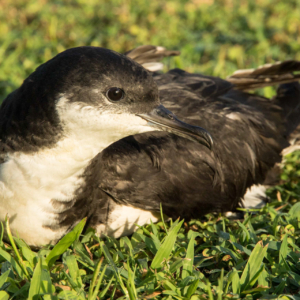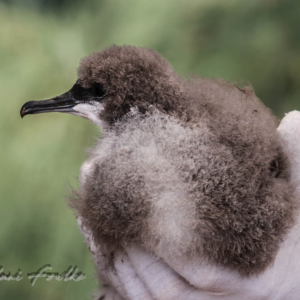Newell’s Shearwater
Status: Indigenous to Hawai’i, IUCN: Endangered
Hawaiian Name: ‘a’o
Scientific Name: Puffinus newelli
Family: Procellariidae
Population: ‘A‘o nest on Kaua‘i, Hawai‘i, Maui, and Moloka‘i, and may also nest on O‘ahu and Lāna‘i, but this is not yet confirmed. Nesting colonies do not occur outside of Hawai‘i. At-sea distribution includes the eastern and central subtropical Pacific Ocean.
Feeding: ‘A’o often forage in large, mixed species groups. They feed mainly by diving into water. Their diet is not well known, but likely consists of fish and squid.
Breeding: ‘A‘o are colonial breeders and nest on steep mountain slopes. They nest underground in burrows or in natural cavities where they lay a single egg. Both parents incubate the egg and feed the nestling. Parents forage hundreds of kilometers offshore and return to the burrow at night to feed their chick.
Life Cycle: Eggs are laid in early June and most young fledge in November. Age at first breeding is six to seven years.
Cultural Information: The ‘a‘o has a huge connection to the culture of Hawai‘i. ‘A‘o are a part of the Kumulipo, which is a Hawaiian creation story. Seabirds in general were an integral part of daily life and were of cultural significance to ancient Hawaiians. Seabirds that feed at sea and return to shore at night were used to navigate back to land from fishing or trading voyages. Fishermen used gatherings of feeding seabirds to lead them to schools of fish, and still do today. Hawaiians also observed seabird behavior to indicate changing weather patterns.
Conservation: ‘A‘o have many threats including introduced predators. Adults and chicks are susceptible to depredation by dogs, pigs, rats, barn owls, feral cats, and mongoose. The presence of these destructive introduced animals, the main force behind population decline, has relegated the species now to nest only in remote interior areas, at high altitudes, or on islands that are predator-free. Feral goats, sheep, and potentially deer trample burrows and degrade nesting habitat.
PRC and ‘A‘o: From 2016-2020 we translocated 86 ‘a’o from montane colonies, to Kīlauea Point National Wildlife Refuge on Kaua’i. The first ‘a’o returned in 2021. Since 2016, PRC has been surveying for ‘a’o on O’ahu using acoustic recording units and in-person auditory surveys. We have detected ‘a’o regularly at Ka’ala and Kaluanui Natural Area Reserves, ’Opae’ula, and in the Ewa Forest Reserve.
Sources: Division of Forestry and Wildlife: Wildlife Program | ʻAʻo (hawaii.gov)
DVIDS – News – Annual Newell’s Shearwater Blessing (dvidshub.net)
Cultural Significance – Kauaʻi Endangered Seabird Recovery Project (kauaiseabirdproject.org)



